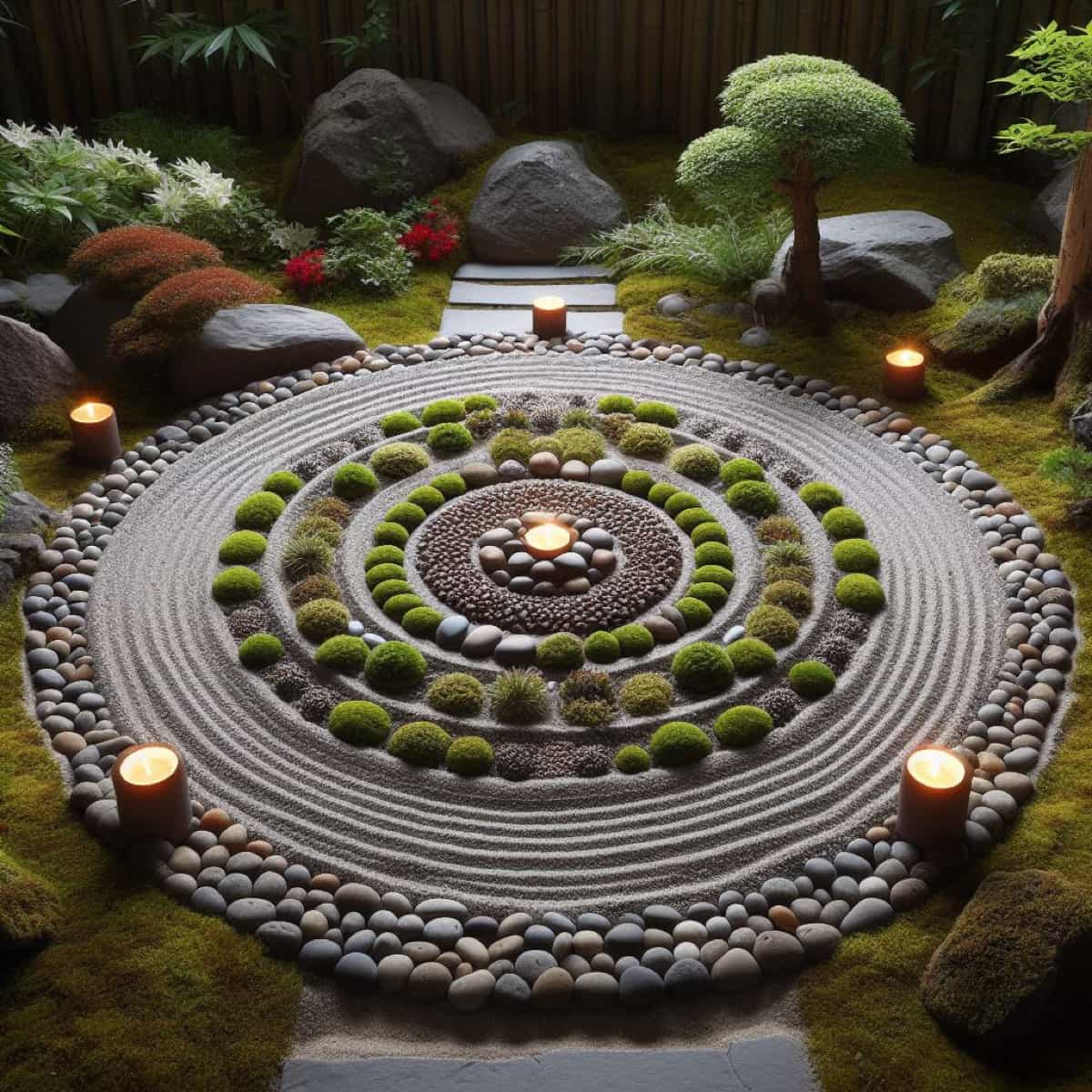This captivating garden design not only adds a touch of beauty to your outdoor space. A Mandala Garden takes on a similar meaning in permaculture by incorporating circular patterns and designs into the layout. The circular shape of a Mandala Garden allows for efficient use of space while promoting biodiversity and productivity.

Furthermore, Mandala Gardens promotes water conservation by capturing run-off water through swales or trenches along the outer edges. This helps retain soil moisture and reduces erosion while nourishing surrounding plantings.
Mandala Garden with Simple Design
Benefits of a Mandala Garden
The main advantage of Mandala Garden is the ability to capture and utilize run-off water effectively. The unique round design allows families to maximize their use of space, making it ideal for small plots with shallow or compacted soil. Another benefit is the ability to grow plentiful vegetables in a small plot of land. The shallow or compacted soil often found in these gardens can be improved through techniques such as mulching and composting.
Mandala Gardens promote biodiversity by attracting pollinators and beneficial insects with strategically planted flowers. This natural pest control reduces the need for harmful pesticides and creates a harmonious ecosystem within the garden. Furthermore, a Mandala Garden promotes sustainable gardening by utilizing companion planting strategies.
Choosing the Right Location and Size for Your Mandala Garden
Find an area that receives ample sunlight throughout the day. Next, assess the soil quality. Look for well-drained soil that is rich in organic matter. Consider proximity to water sources as well. A Mandala Garden requires regular watering, so having easy access to a water supply will make maintenance much easier.
The size of your Mandala Garden will depend on available space and personal preferences. Small-scale Mandala Gardens can fit in tight spaces such as balconies or small yards, while larger plots allow for more diverse planting options.
Designing a Simple Layout for Your Mandala Garden
Start by choosing the right location for your Mandala Garden. Look for an area with ample sunlight throughout the day and good drainage. Consider the size of your plot as well, keeping in mind that smaller gardens are easier to manage. Next, decide on the shape and size of your Mandala design.
Once you have determined the shape, divide your garden into sections or beds using pathways made from materials like gravel or wood chips. When selecting plants for a Mandala Garden, consider their growth habits and compatibility with neighboring plants. Don’t forget about water conservation techniques such as mulching and drip irrigation systems, which can reduce water usage while promoting soil health.
Selecting Plants for a Productive and Sustainable Mandala Garden
Selecting the right plants for your Mandala Garden is crucial for achieving productivity and sustainability. When choosing plants, consider their compatibility and ability to thrive in climate and soil conditions.
- Vegetables: Tomatoes, Peppers, Eggplants, Cucumbers, Beans, Peas, Carrots, Beets, Radishes, Onions, Garlic, and Lettuce.
- Herbs: Basil, Thyme, Rosemary, Oregano, Chives, and Parsley
- Flowers: Sunflowers, Marigolds, Zinnia, Cosmos, and other flowers that attract pollinators.
- Root crops: Yam, Taro, Beetroot, Radishes, and many more
In case you missed it: How to Create a Wildflower Meadow Patch With Annuals and Perennials

Implementing Water Conservation Techniques in Your Mandala Garden
Minimizing water usage can reduce environmental impact and ensure plants thrive in dry conditions. One effective technique is mulching, which involves covering the soil around plants with organic materials. Using drip irrigation systems is another great way to conserve water. These systems deliver water to the plant roots, minimizing waste through evaporation or run-off. Collecting rainwater in barrels is an excellent method to supplement your watering needs.
Incorporating Companion Planting Strategies in Your Mandala Garden Design
Companion planting involves growing different plants together to benefit each other. In your Mandala Garden, incorporating companion planting strategies can enhance your plants’ overall health and productivity. One popular example of companion planting is pairing tomatoes with basil. Another effective strategy is interplanting flowers like marigolds or zinnias alongside your vegetable crops. Furthermore, consider adding herbs like thyme or rosemary near your vegetables. These aromatic herbs act as natural repellents against pests while providing culinary benefits.
Creating Pathways and Access Points in Your Mandala Garden
To create pathways, you can use mulch, gravel, stepping stones, or wood chips. Consider using eco-friendly materials that blend well with your garden’s overall design. Strategic placement of access points is crucial for efficiently managing your Mandala Garden. Incorporating curved paths rather than straight ones adds visual interest and creates a natural flow within your garden.
Maintaining and Managing Your Mandala Garden for Long-term Success
Regular watering is essential to ensure the health of your plants. Set up a drip irrigation system or water by hand, making sure to water deeply and evenly. This will help prevent dry spots and promote even growth. Proper weed control is necessary to minimize competition for nutrients and space. Regular pruning and harvesting are important tasks in maintaining a productive Mandala Garden. Implement organic pest control methods like companion planting or introducing beneficial insects to combat these issues naturally.
Enhancing Biodiversity and Wildlife Habitat in Your Mandala Garden
You can create an ecosystem supporting various plants, insects, birds, and other animals by incorporating design elements and planting strategies. Consider planting sunflowers, marigolds, zinnias, cosmos, and other nectar-rich varieties to attract pollinators. Creating different layers within your garden can also increase biodiversity. For example, include tall trees or trellises for climbing plants like beans or cucumbers. Another strategy is incorporating water features like small ponds or bird baths. These invite watering holes for birds and other creatures during dry periods.
Harvesting and Utilizing the Yield from Your Mandala Garden
Harvesting from your Mandala Garden is satisfying and ensures access to fresh, organic produce right at your fingertips. Consider preserving excess produce for future use to make the most of your yield. Remember that harvesting doesn’t mean removing all plants; some crops can continue producing throughout multiple seasons. For example, leafy greens like lettuce can be harvested by cutting off the outer leaves while leaving the inner ones intact for regrowth.
In case you missed it: A Comprehensive Guide to Creating a Winter Vegetable Garden in 10 Simple Steps

Frequently Asked Questions About Mandala Garden
What is a Mandala Garden?
It’s an innovative and resourceful solution for families looking to maximize their garden space while conserving water. These gardens are designed in a round shape, allowing them to capture precious run-off water and make the most of small plots of land. They are particularly useful for areas with shallow or compacted soil. The design of a Mandala Garden is based on the ancient concept of Mandalas, which symbolize balance and harmony.
How do I Maintain and Manage My Mandala Garden Effectively?
Regular maintenance tasks include watering appropriately based on plant requirements, weeding regularly, removing pests manually or using organic methods, and providing necessary support for climbing plants.
Should I Create Pathways Within My Mandala Garden?
Pathways allow easy access to all parts of your garden and prevent trampling on delicate plants. Consider using materials like wood chips or gravel, both functional and aesthetically pleasing options.
Is It Necessary to Follow Specific Dimensions for Each Section?
While there are no hard rules for sizing each section, allocating larger areas for perennial crops like fruit trees or shrubs and smaller spaces for annual vegetables or herbs that require regular replanting is advisable.
In case you missed it: How to Create a Sensory Garden for Therapeutic Benefits: A Step-by-Step Guide

How do I Maintain My Mandala Garden?
Regular maintenance involves weeding, mulching, watering when needed, pruning plants if required, monitoring pests/diseases diligently but organically (using companion planting techniques), composting kitchen scraps/yard waste, and applying organic fertilizers occasionally.
Steps to Create a Mandala Garden
| Steps | Description |
| Know about the concept of Mandala Gardens | Adds a touch of beauty to outdoor space, allows for efficient use of space |
| Right location | Find an area in your yard with ample sunlight and good drainage. |
| Design a simple layout | It helps maximize space and accessibility. |
| Choose suitable plants | Select plants that are productive and sustainable for your garden. |
| Water conservation techniques | Using drip irrigation systems, mulching, and collecting rainwater |
| Incorporate companion planting strategies. | To enhance your plants’ overall health and productivity |
| Create pathways | Use materials such as mulch, gravel, stepping stones, or wood chips, using eco-friendly materials. |
| Maintain and manage the garden regularly. | Proper weed control, regular pruning, and harvesting, monitoring pests and diseases |
| Enhancing biodiversity and wildlife habitat | Attract pollinators, create different layers, incorporate water features |
| Harvesting and utilizing the yield | Harvested by cutting off the outer leaves for leafy greens, preserving excess produce for future use |
Conclusion
Unlike traditional rectangular or square gardens, the round shape of a Mandala Garden allows for efficient use of space and easy access to all areas. The importance of a Mandala Garden lies in its ability to provide sustenance and create a sustainable ecosystem. Mandala Gardens minimizes the use of harmful chemicals and synthetic fertilizers. Mandala Gardens also contribute to food security by providing a diverse range of vegetables, herbs, fruits, and flowers all year round.
- Feed Your Flock for Less: Top 10 Tips to Save on Chicken Feed
- Ultimate Guide to Ossabaw Island Hog: Breeding, Raising, Diet, and Care
- Hatching Answers: The Top 10 Reasons Your Chickens Aren’t Laying Eggs
- Eggs and Economics: Breaking Down the Cost of Raising Backyard Chickens
- Defend Your Greens: Proven Methods to Keep Iguanas Out of Your Garden
- Ultimate Guide to Cinnamon Queen Chicken: A Comprehensive Guide for Beginners
- Ultimate Guide to California Tan Chicken: Breeding, Raising, Diet, Egg-Production and Care
- Ultimate Guide to Marsh Daisy Chicken: Breeding, Raising, Diet, and Care
- 10 Types of Chicken Farming Businesses You Can Start for Profits